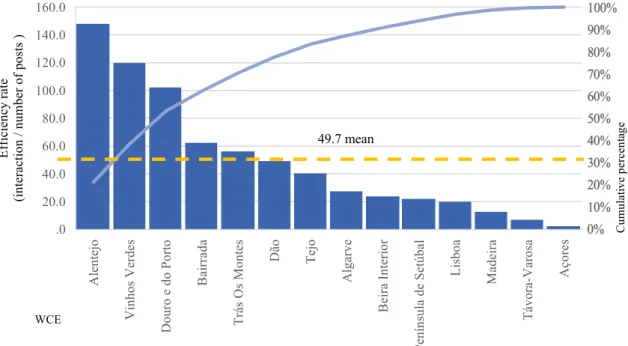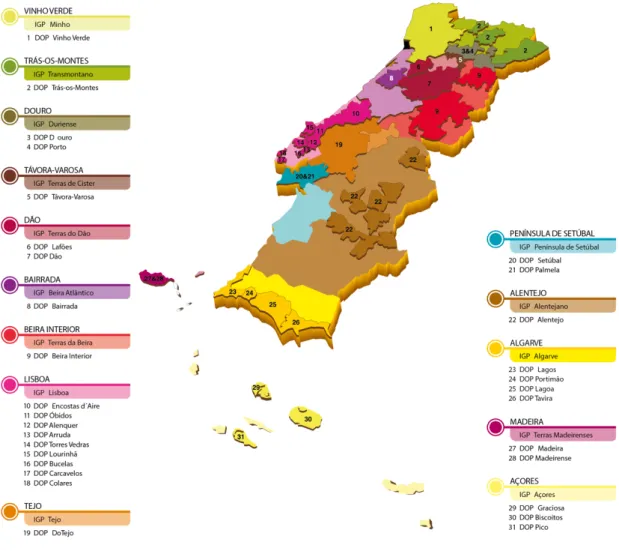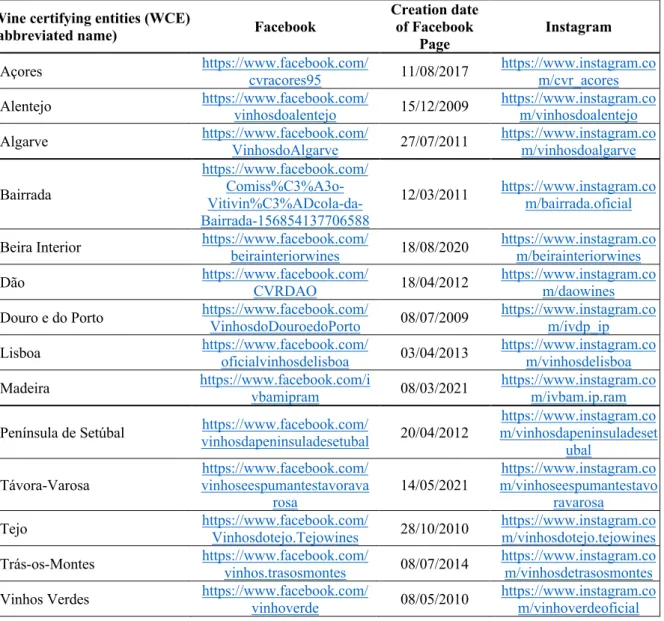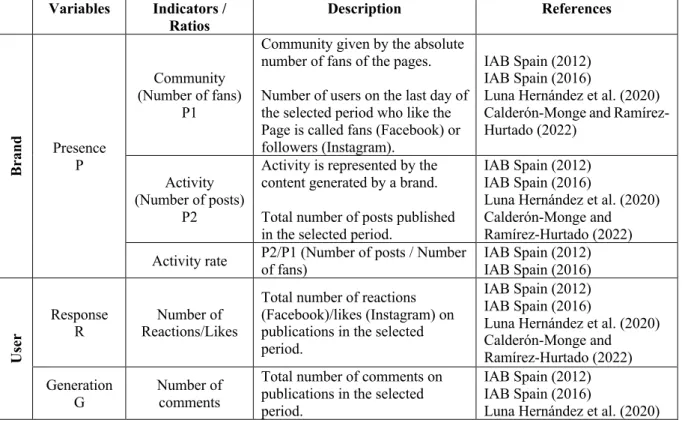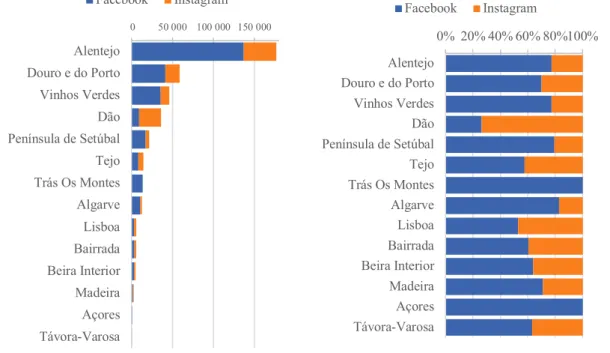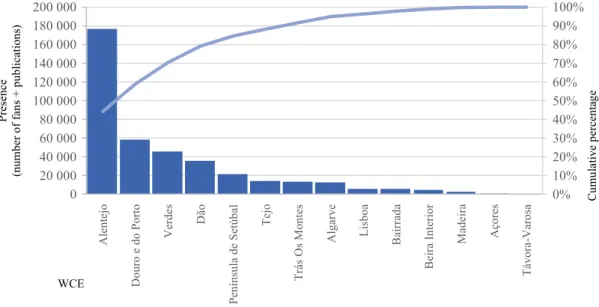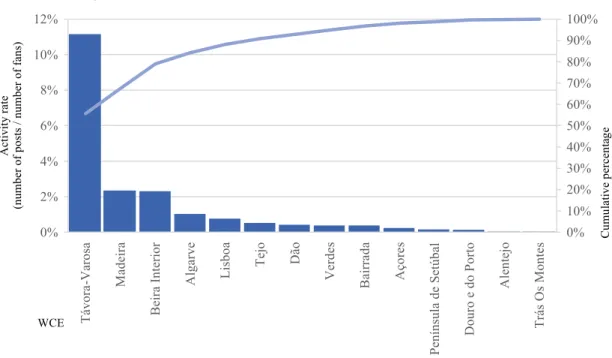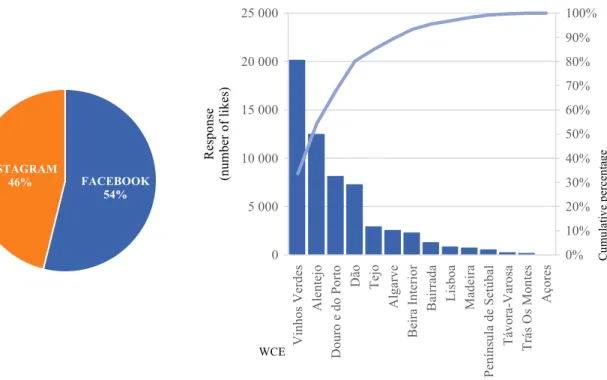Facebook is the most popular social media network worldwide, with 2,910 million users worldwide as of January 2022 (Statista, 2022; DataReportal, 2022). Instagram is also one of the most popular and used social media channels worldwide, with a very progressive growth in recent years, with 814.5 million users worldwide, in 2019. The Internet is an excellent platform for wine promotion, especially on social media sites such as Facebook and Instagram (Costopoulou et al., 2018).
This concept has gained value and is currently developing through content and the participation of customers on social media platforms by brands or businesses (Egaña et al., 2021). Additional research by Ingrassia et al. 2018) illustrates the usefulness of mobile applications and QR codes in the wine purchase decision and the importance of social media in today's wine marketing strategies. This study aims to analyze the activity and effectiveness of social media channels Facebook and Instagram by the Portuguese wine certification entities (WCE) following an exploratory and comparative approach.
Instagram is also one of the most popular and used social media channels worldwide, with very progressive growth in recent years (Statista, 2022). However, an adaptation of the updated PRGS model was used to analyze the Facebook and Instagram social media pages of the Portuguese WCE (see Table 4). Presence measures the size of the community and the extent of a brand's activity due to brand-generated content on social media.
This presence variable measures the size of the community (P1) with the number of fans and the amount of brand activity with the number of publications (P2) on social media.
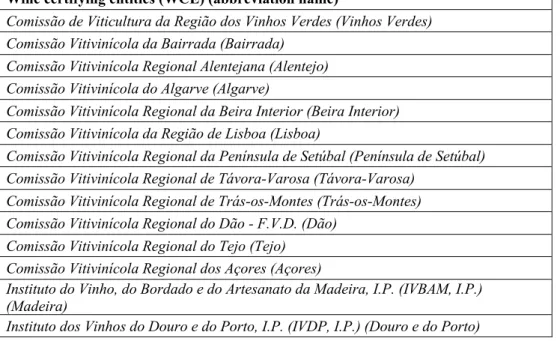
Community (P1) analysis
When both social network numbers are compared, all pages have more prominent communities on Facebook, except Dão's WCE page, which has a much larger community on Instagram than Facebook (see images 3, 4, and 5). The number of posts on Facebook during the period analyzed is very high for the WCE of Vinhos Verdes page (99), with the highest numbers on both social networks (178), followed by the WCE of Dão (151) and Algarve (134) . The WCE of Vinhos Verdes and of Alentejo pages stand out for the number of likes shown in Figure 10, with the highest number of likes on Facebook respectively.
The WCE of Távora-Varosa page has a very low number of likes, which can be explained as they have the smallest community on Instagram. The WCE of Dão, Douro e do Porto and Vinhos Verdes pages stand out as the WCE with the highest numbers of reactions and likes on Instagram. The Facebook numbers for the WCE from Vinho Verdes Verde and Alentejo pages are very high compared to the Instagram numbers, which are weaker (see Figures 11 and 12).
The page WCE of Távora-Varosa has the smallest number of fans on Facebook, but not the lowest number of comments among the pages analyzed, only with a higher number than the page WCE of Açores. The WCE from Algarve page stands out with many Instagram comments, as shown in Figures 14 and 15; the rest of the pages have significantly lower numbers. The three WCE from Vinhos Verdes, Alentejo and Douro e do Porto are above but close to the average value of 139 comments, a much smaller range compared to the 942 comments from the Algarve page WCE (see Figure 16).
This difference could be explained due to some WCE giveaways from the Algarve site or even content that promoted interaction through comments like questions. WCE from Vinhos Verdes, Douro e do Porto represent almost 50% of the total value, and combined with WCE from Alentejo, they represent almost 70%. Looking at the shares for scores per fan in figure 20, the WCE site from Beira Inland stands out, followed by the WCE sites from Madeira, Távora-Varosa and Vinhos Verdes with values above average.
This indicator leads the WCE of Beira Interior with more than 3.0% of the value, at the indicator with an average value of 1.0% for all WCEs. The level of involvement measures the intensity of user implications with WCE, which combines user interaction with community size (P1), represented by the number of fans and between. Looking at the results of the Engagement rate indicator in Figure 25, the WCE site from Távor-Varos stands out.
The engagement rate results were highly influenced by the size of the communities, with the WCE from the Távora-Varosa site having a smaller community than the WCE in the study having the best engagement rate. In contrast, despite having the largest number of fans, WCE from the Alentejo fan page has a relatively low engagement rate compared to most WCEs.
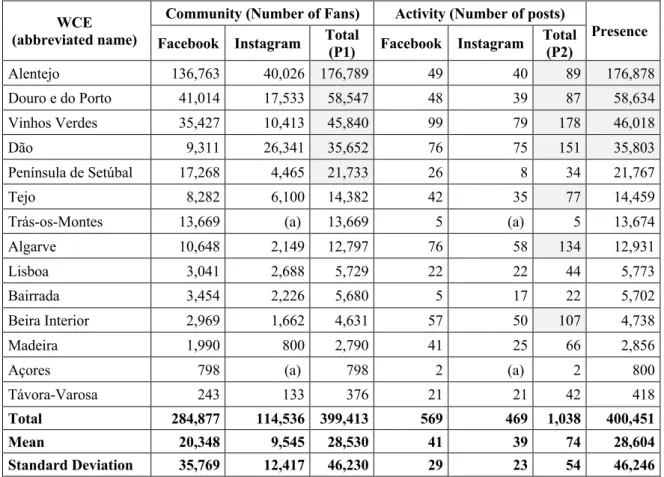
Efficiency rate analysis
This result means that this combination of user interaction and community size is the most important, followed by WCE pages from Beira Interior, Vinhos Verdes, Madeira and Algarve with above average values. The fifth and final group with a sum of percentage weights less than 10% is formed by the remaining six of the fourteen WCEs. The research measured the indicators of this model using data obtained from the online social media monitoring and data collection tool Fanpage Karma.
Overall, the analysis shows that all the Portuguese WCEs are present on both studied social media (Facebook and Instagram) and some use their pages in a very active way that also contains large communities with relevant interactions from them. Facebook was the first social media adopted for most of these devices, and Instagram has gradually been introduced to the marketing dynamics of these devices in recent years, which may explain why some communities show low numbers compared to Facebook. Although all entities are present in both social media channels, some of the variables tell us that Instagram is something new for some of these entities and they are still developing and expanding their communities, as their number of likes is inferior compared to Facebook.
The number of posts made on these two social media platforms shows that Facebook dominates most sites. Publications should be frequent and have content adapted from Facebook and Instagram because social media is an audiovisual channel for communication and customer service par excellence. All WCE Instagram pages are advised to maintain a more balanced presence on this social media platform by posting more.
For the Suggestion variable represented by recommendations or by the number of shares indicator, Instagram is not analyzable as this feature is not available in this social media network, only for Facebook. The degree of engagement that measures user interaction with the size of the community and over the number of months from the analysis period, the WCE site from Távora-Varosa is one of the main points, followed by the WCE sites from Beira Interior, Vinhos Verdes, Madeira, and Algarve, all with above average values. When comparing the number of interactions on the two social media platforms, Facebook pages have the lowest number despite having larger communities.
Creative strategies in social media marketing: An exploratory study of branded social content and consumer engagement. Social media strategies and corporate brand visibility in the wine industry: Lessons from an Italian case study. Retrieved March 17, 2022, from DataReportal – Global Digital Insights website: https://datareportal.com/social-media-users De las Heras-Pedrosa, C., Millan-Celis, E., Iglesias-Sánchez, P .
Measuring consumer engagement with brand-related social media content: Development and validation of a scale identifying levels of social media engagement with brands. The Millennial Generation and Environmental Sustainability: The Role of Social Media in Consumer Purchase Behavior for Wine.
